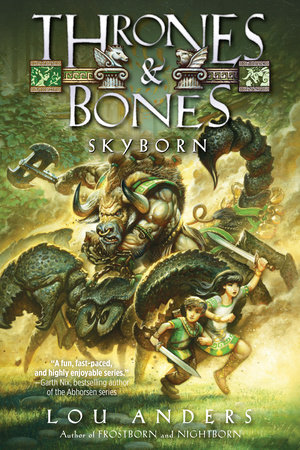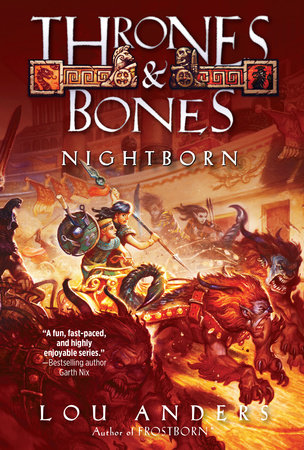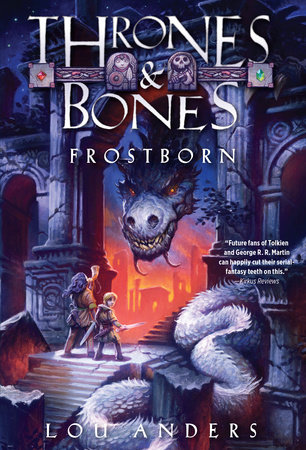Author Lou Anders On Norse Mythology, Strong Female Heroines, and Gaming
by the Brightly Editors
Author Lou Anders’s research on Norse mythology while writing book one in the acclaimed Thrones & Bones series, Frostborn, turned into a love affair with Viking culture and a first visit to Norway. Brightly sat in as Lou Anders and his editor, Phoebe Yeh, chatted about the series, which now includes Nightborn and Skyborn, the second and third books in the fantasy-adventure trilogy. Read on as the two discuss the inspiration behind the series, the importance of gender-balanced characters, and the role of board games in his books.
On Norse Inspiration
Phoebe Yeh: Karn, the co-hero of Nightborn and Frostborn in the Thrones & Bones series, is a Norse boy. Why were you inspired to write about Viking culture and Norse mythology? Were you a fan of Norse myths, growing up?
Lou Anders: Somewhere in my parents’ closets there’s a half-finished painting I did of Thor bringing the hammer Mjölnir down on the head of the Midgard Serpent. I think I got the art out of a role-playing game manual, using a projector and a pencil to transfer it to a large canvas. Although I never completed the painting, I loved it for what it inspired in me.
I think I first encountered the Norse gods in the fantasy stories of Fritz Leiber, where an old and bitter Odin makes an appearance, and then learned more about Norse myth in role-playing games. I was always fascinated by the idea of a pantheon that knew how and when it was going to end, the fact that the gods carried on even though they all knew that doom was inevitable.
But when I had my first inkling of crafting the world of Thrones & Bones, it wasn’t a love of Norse mythology that dictated the setting so much as the intimidating factor of tackling fantasy fiction. I’ve worked in publishing for fifteen years and the majority of my friends are fantasy authors and artists. I wanted to tackle world building by degrees, and I thought it would be safe and simple to start with the roots of Western fantasy tradition and slowly work my way out from there. I didn’t really understand the degrees to which the Scandinavian culture underpins so much of English-language fantasy or how far-reaching their influence was. The project became bigger and bigger the more I researched, as the Vikings’ own interactions with the rest of Europe forced me to consider the history of my Norrønir’s interactions with their continent of Katernia. What I thought was a simple setting in the frozen edge of a larger world became the lynchpin for thousands of years of history that I worked out across multiple countries. All of this is the tip of an iceberg that barely peeks into the Frostborn narrative, but I had to understand it myself before I could write a credible world. In Nightborn, we get to step out a little further, visiting two more cities in two new countries, and learning more of the history of the world and the various peoples that inhabit it.
On Heroes & Heroines
Phoebe Yeh: Karn and Thianna are the heroes of Frostborn. In Nightborn, we meet Tanthal and Desstra. They are smart and foolish, courageous and quick-tempered. Why was it important for you to have strong boy and girl characters in each novel?
Lou Anders: I’ll start by saying that it wasn’t just important that I had a strong girl character, it was of paramount importance. The entire idea began with Thianna, who was born of my desire to have a girl character that wasn’t relegated to being the sidekick or defined as being the brains of the operation or the magical supporting player backing up a sword-wielding male lead. I wanted a girl who was the muscle of the team, the one more likely to rush into danger, to hit first and ask questions later. When she was created, I then had to craft a boy to complement but not duplicate her own personality. Since Thianna was brash and impulsive, I decided that Karn would be more introspective and careful. Since she was an athlete, I decided his hobbies would be board games. In a lot of ways, he evolved as her mirror opposite. But as to why I wanted to do this? Well, I’m a father of two wonderful kids, one boy and one girl, and I wanted to write a story I’d be proud to give to both of them. She plays sports and he plays video games, and yes, they each have their own interests, but their interests also overlap in a lot of places. I don’t understand why you would ever set out to write for just half your potential audience, though that’s what a lot of the fantasy authors I grew up on were doing. The Thrones & Bones series is very deliberately an attempt to share the kind of fantasy fiction I read as a child with a new generation, while being deliberately gender-balanced and ethnically diverse. (Thianna is also biracial, as are my own kids.)
On Games
Phoebe Yeh: Readers who play video games will relate to Karn, gamer boy. In each novel, you create a board game that is part of the storyline. In Frostborn, Karn is an avid fan of the board game Thrones & Bones. What Norse game does it resemble? How did you modify the rules in Thrones & Bones?
Lou Anders: There’s a real historical game known as hnefatafl. The name may mean “board game of the fist.” It was played across the Scandinavian world until around the twelfth century, when it was gradually replaced by chess. We know it was a big part of Viking culture because it is mentioned in the medieval sagas and we’ve uncovered sets in burial mounds. However, we don’t have an extant version of the rules. There have been several attempts to reconstruct the rules from specific moves gleaned from the sagas, but the reconstructions differ widely, right down to variants in the number of pieces and the dimensions of the board.
When I was writing Frostborn, I thought that I could get by with just using one of the hnefatafl reconstructions, but as I got into the book and saw just how crucial the game was going to be to Karn’s character and the overall plot, I realized that I really needed to understand the rules completely. But when I looked at the reconstructions, I wasn’t happy with any one set. So I decided I’d create my own game, something similar to hnefatafl but not a copy. Like another world’s analogous version of the Scandinavian game, which, of course, is what it is. (I think it was Fritz Leiber who called chess “that demon game they say exists in every world.” I love that notion, probably the reason I like creating fantasy board games from other worlds to begin with.)
So, anyway, I stopped writing, went to a hobby and crafts store, and bought a 12”x12” board, wooden dowels, and paint pens. I spent a week creating the game and working out the rules. Then I called my two oldest nephews, who happen to be chess champions in the State of Alabama, and took them to Starbucks. There, I let them play each other for three hours. When I had to pry the game out of their hands forcefully so I could get home for dinner, I knew I had something.
I should add that the game for Nightborn is called Charioteers. It’s a dice game mean to be a simulation of the chariot races in the hippodrome of my city of Gordasha. Unlike Thrones & Bones, it’s not based on any one game. I looked deeply into the historical antecedents of backgammon, at games like the Egyptian Senet and and the Royal Game of Ur, but I ended up creating my own game from scratch. It’s less a strategy game than Thrones & Bones is, but it is a fun game that encourages competition and cooperation in equal measure with some, I think, unique twists.
Lou Anders drew on a recent visit to Norway along with his adventures traveling across Europe in his teens and twenties to write Frostborn and Nightborn, combining those experiences with his love of globe-trotting adventure fiction and games (both tabletop and role-playing) However, he has yet to ride a wyvern. With the addition of characters Desstra and Tanthal, Anders hopes that his second book in the Thrones & Bones series will continue to appeal to boys and girls equally. Anders is the recipient of a Hugo Award for editing and a Chesley Award for art direction. He has published over five hundred articles and stories on science fiction and fantasy television and literature. A prolific speaker, Anders regularly attends writing conventions around the country. He and his family reside in Birmingham, Alabama. You can visit Anders online at louanders.com and ThronesandBones.com, on Facebook, on Tumblr, and on Twitter at @ThronesandBones and @LouAnders.
-
Books in the Thrones & Bones Series
-



